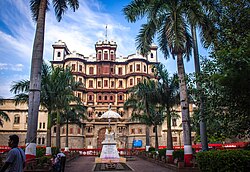Indore
| Indore Hindi इंदौर |
||
|---|---|---|
|
|
||
| State : |
|
|
| State : | Madhya Pradesh | |
| District : | Indore | |
| Location : | 22 ° 43 ' N , 75 ° 52' E | |
| Height : | 550 m | |
| Area : | 172 km² | |
| Residents : | 1,992,422 (2011) | |
| Population density : | 11,584 inhabitants / km² | |
| Postal code : | 452001-452018 | |
| Website : | Indore | |
| Indore - Rajwada Palace | ||
Indore ( Hindi इंदौर ) with around 2.2 million inhabitants is the largest city in the district of the same name in the west of the central Indian state of Madhya Pradesh .
location
Indore lies at an altitude of about 530 m at the confluence of the Khan and Saraswati rivers on the Vindhya plateau . The distance to Bhopal is almost 200 km (driving distance) in a north-easterly direction; the holy city of Ujjain is about 56 km north. The climate is warm to hot; Rain (approx. 985 mm / year) falls almost exclusively in the summer monsoon months .
population
| year | 1991 | 2001 | 2011 |
| Residents | 1,091,674 | 1,477,793 | 1,994,397 |
The population of Indore consists mainly of Hindus (approx. 80.5%), Muslims (a good 14%) and Jains (approx. 3.5%); smaller minorities are Sikhs , Christians and Buddhists . As is customary in censuses in India, the male population clearly exceeds the female population. Mostly Malwi and Hindi are spoken .
economy
Agriculture ( cotton , millet , maize , rape and wheat ) in the area has formed the basis of economic life for thousands of years; Traders, craftsmen and service providers of all kinds have settled in the city itself. Before Bhopal, Indore is the largest industrial city (cotton, metal, furniture, chemical industry) of Madhya Pradesh; the city has a cultural center with a university , theater , museums and cinemas . It is also an important transport hub ( road , rail , airport ) and a research center with scientific institutes.
history
After Indore was only an insignificant station on the pilgrimage routes to Omkareshwar and Ujjain for centuries , it developed into an important trading center in the region from 1715. Malhar Rao Holkar (1694–1766), the founder of the Holkar dynasty , made Indore the capital of his empire of the same name . From 1818 to 1947, the British assumed nominal rule, whereas the Holkars continued to rule. Since 1956 Indore belongs to the then newly founded state of Madhya Pradesh.
Attractions
Indore is a new city; there are no medieval temples etc. The palaces of the Holkar dynasty are well worth seeing. For example, the Lal Bagh Palace on the banks of the Khan , which can serve as an example of the extravagant neoclassical buildings of the immensely wealthy maharajas of the 19th and 20th centuries. The landmark of Indore is the old Holkar Palace Raj Wada , which overlooks a palm -lined square in the heart of the city; the building was built in the style of a West Indian townhouse. Another palace is the Manik Bagh . Also worth seeing are the temple-like memorial buildings ( chhatris ) of the ruling dynasty as well as some Hindu, Jain and Sikh temples from more recent times.


